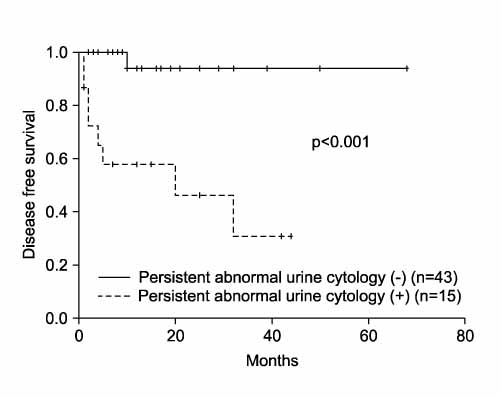Korean J Urol.
2009 Feb;50(2):125-129.
The Significance of Persistent Abnormal Urine Cytology
- Affiliations
-
- 1Department of Urology, Hanil General Hospital, Seoul, Korea. uroahn@dreamwiz.com
- 2Department of Urology, Chung-Ang University College of Medicine, Seoul, Korea.
Abstract
- PURPOSE
We investigated the factors that predicted later transitional cell carcinoma (TCC) in a subgroup of patients with abnormal cytology and negative initial evaluations.
MATERIALS AND METHODS
From January 2002 to June 2007, we retrospectively identified 58 patients. Cases were considered discordant if a work-up of urine cytology was abnormal although initial cystoscopy, upper tract evaluation, and biopsies resulted in a negative or benign diagnosis. Patients who could complete a urine cytology test after 6 to 8 weeks and who were followed up for at least 1 year were included in this study. According to later TCC demonstration, we compared risk factors for TCC between the later TCC group and the benign group and evaluated the independent factors that predicted later TCC by use of a Cox proportional hazards regression model.
RESULTS
Of the 58 patients, the mean follow-up was 12.7+/-17.3 months (range: 2-83 months), and 14 patients (23.7%) had a prior history of TCC. During follow-up, 9 patients (15.3%) had TCC and 1 patient had prostate cancer. In the later TCC group, the incidence of a prior history of TCC (p=0.03) and persistent abnormal cytology (p<0.001) were higher than in the benign group in univariate analysis. In the Cox proportional hazards regression model, persistent abnormal cytology (p=0.033, relative risk (RR): 17.380 [95% CI: 1.265-238.783]) was the only independent factor to predict later TCC. The mean follow-up duration of later TCC demonstration was 8.55 months (range: 2-32 months).
CONCLUSIONS
Our results suggest that in the setting of persistent abnormal urine cytology with a negative initial evaluation, 53.3% of patients will later develop TCC. Patients with persistent abnormal cytology need intensive follow-up within 1 year.
Keyword
MeSH Terms
Figure
Reference
-
1. Bastacky S, Ibrahim S, Wilczynski SP, Murphy WM. The accuracy of urinary cytology in daily practice. Cancer. 1999. 87:118–128.2. Grossfeld GD, Litwin MS, Wolf JS Jr, Hricak H, Shuler CL, Agerter DC, et al. Evaluation of asymptomatic microscopic hematuria in adults: the American Urological Association best practice policy--part II: patient evaluation, cytology, voided markers, imaging, cystoscopy, nephrology evaluation, and follow-up. Urology. 2001. 57:604–610.3. Koshikawa T, Leyh H, Schenck U. Difficulties in evaluating urinary specimens after local mitomycin therapy of bladder cancer. Diagn Cytopathol. 1989. 5:117–121.4. Nabi G, Greene D, O'Donnell MO. Suspicious urinary cytology with negative evaluation for malignancy in the diagnostic investigation of haematuria: how to follow up? J Clin Pathol. 2004. 57:365–368.5. Koss LG, Deitch D, Ramanathan R, Sherman AB. Diagnostic value of cytology of voided urine. Acta Cytol. 1985. 29:810–816.6. Kwon DH, Hong SJ. The clinical utility of BTA TRAK, BTA stat, NMP22 and urine cytology in the diagnosis of bladder cancer: a comparative study. Korean J Urol. 2003. 44:721–726.7. Deshpande V, McKee GT. Analysis of atypical urine cytology in a tertiary care center. Cancer. 2005. 105:468–475.8. Bhatia A, Dey P, Kakkar N, Srinivasan R, Nijhawan R. Malignant atypical cell in urine cytology: a diagnostic dilemma. Cytojournal. 2006. 3:28.9. Jo MK, Chung JS, Lee SE. The significance of atypical cell in urinary cytology. Korean J Urol. 1998. 39:9–14.10. Rupp M, O'Hara B, McCullough L, Saxena S, Olchiewski J. Prostatic carcinoma cells in urine specimens. Cytopathology. 1994. 5:164–170.11. Krishnan B, Truong LD. Prostatic adenocarcinoma diagnosed by urinary cytology. Am J Clin Pathol. 2000. 113:29–34.12. Leibovitch I, Lew S, Sternberg I. The clinical significance fo a suspicious (Class III) urine cytology sample. American Urological Association 2007 Annual Meeting. 2007. Anaheim.13. Kroft SH, Oyasu R. Urinary bladder cancer: mechanisms of development and progression. Lab Invest. 1994. 71:158–174.
- Full Text Links
- Actions
-
Cited
- CITED
-
- Close
- Share
- Similar articles
-
- Comparative Examination on Bladder Washings and Urine for the Diagnosis of Bladder Cancer in Cytology
- The role of flow cytometry in urine cytology
- The Significance of Repeat Bladder Biopsy after Intravesical Bacillus Calmette-Guerin Therapy for High Risk Superficial Transitional Cell Carcinoma of Bladder
- The Value of Urine Cytology and Flow Cytometry in Superficial Bladder Tumors
- The Value of Urine Cytology on Bladder Tumor



